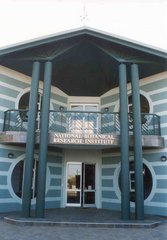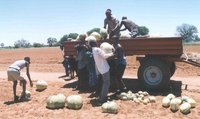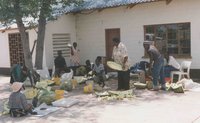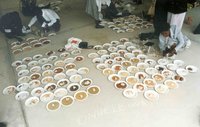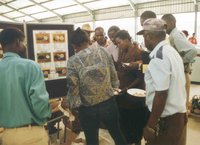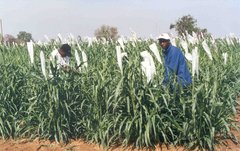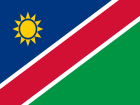
Namibia National Plant Genetic Resources Centre

Background
|
|
The Namibian NPGRC was established in 1990 but activities started only in 1993 after the curator had been trained. The centre is located in the capital of Namibia, Windhoek, and is a section of the National Botanical Research Institute (NBRI) of the Directorate Agricultural Research and Training in the Ministry of Agriculture, Water and Rural Development.
Namibia is a Contracting Party to the International Treaty on Plant Genetic Resources for Food and Agriculture (ITPGRFA). The collection of plant genetic resources listed in Annex I of th Treaty and maintained at NPGRC have been included in the Multilateral System. These will be made available to users under the conditions of the Standard Material Transfer Agreement of the ITPGRFA.
Objectives
- To conserve genetic resources of indigenous wild, cultivated and other useful introduced plant species in Namibia through both in situ and ex situ methods;
- To characterise and evaluate local germplasm;
- To promote the utilisation of local plant genetic resources;
- To do research on plant genetic resources in Namibia;
- To serve as contact point for regional and international plant genetic resources initiatives.
Collaboration
NPGRC collaborates with the Millennium Seed Bank Project of the Royal Botanic Gardens, Kew's Seed Conservation Department (UK). This concentrates on collecting seed of wild plants of conservation concern.
Nationally there is informal collaboration with many institutions, initiatives and projects, like the Agronomy Section of the Ministry of Agriculture, the Ministry of Environment and Tourism, the Indigenous Plant Task Team (promoting sustainable use of indigenous plant resources) and the National Biodiversity Programme.
Activities
Achievements
- Establishing the national germplasm collection and maintaining it to international standards;
- Hosted Cucurbit multiplication and characterisation course for SPGRC network;
- Contributed towards development of, and ratified the ITPGRFA in July 2004.
|
|
|
Current Projects
- A project on evaluation of melon (Citrullus lanatus) germplasm to identify the best seed oil producing line, is currently underway. The seed oil has considerable commercial value and is the basis of local industry for the export market.
- During the recent past a staff member has compiled a red data list for Namibian plants and prepared a book which is to be published soon. This will form the basis for in situ conservation of wild plants.
|
Seed Fair |
|
Collections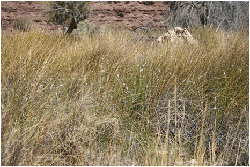
At present the NPGRC houses 3010 accessions. Of these, about 1140 are of wild species and 1870 are crops. The main crops housed are pearl millet (Pennisetum glaucum) and sorghum (Sorghum bicolor subsp. bicolor), with some accessions also of melon (Citrullus lanatus), cowpea (Vigna unguiculata subsp. unguiculata), bambara groundnut (Vigna subterranea), groundnut (Arachis hypogaea) and maize (Zea mays). Wild species collection is focused mainly on useful species or species of conservation concern.
Multiplication
The Namibian NPGRC has multiplied about 670 crop accessions (36% of all crop accessions). The remaining 1200 accessions to be multiplied are mainly of pearl millet. Multiplication is done in collaboration with research stations of the min istry. These are located a minimum of 450 km away from the NPGRC, which makes this activity quite a challenge.
Characterisation
Characterisation activities are always carried out together with multiplication and the same statistics as above apply.
Ex-situ Conservation
For its ex-situ conservation, the NPGRC collectas seeds of both wild and cultivated indigenous plants. These seeds are cleaned, dried, sealed in air-tight foil packets and stored in deep freezers at -200C. Further activities of the NPGRC include description of plant traits of each seed sample, periodic germination tests, documentation of all information from collection to storage and distribution of seeds to bona fide requesters.
In-situ Conservation
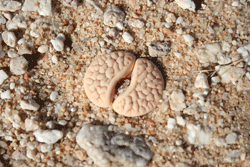 In-situ conservation of wild plant genetic resources looks at conservation of plant resources at their site of occurrence. The NPGRC has concentrated on the identification of Namibia's most threatened plant species by compiling a Red Data List using IUCN categories for assessment. Already a Red Data book has been published to increase awareness among Namibians of the rare and threatened plants and includes descriptions, maps and pictures. Furthe, the NPGRC endures to identifyareas with high concentrations of rare and threatened plants worthy for conservation (in collaboration with the Ministry of Environment and Tourism).
In-situ conservation of wild plant genetic resources looks at conservation of plant resources at their site of occurrence. The NPGRC has concentrated on the identification of Namibia's most threatened plant species by compiling a Red Data List using IUCN categories for assessment. Already a Red Data book has been published to increase awareness among Namibians of the rare and threatened plants and includes descriptions, maps and pictures. Furthe, the NPGRC endures to identifyareas with high concentrations of rare and threatened plants worthy for conservation (in collaboration with the Ministry of Environment and Tourism).On-farm conservation of indigenous landraces of pearl millet, sorghum, locally adapted legumes and cucurbits, considers the reasons why local farmers keep growing these landraces, where they come from and how much diversity they contain. It promotes on-farm conservation of landraces that are adapted to Namibia's climatic conditions as these genetic resources form the basis of plant breeding programmes.
Documentation
The NPGRC uses the documentation programme common to the SPGRC Network. Currently all available data (management, collection, characterisation) have been entered in the database. Due to the switch-over from a DOS-based to a Windows-based version of the software, however, there still remains a lot of data verification and updating to be done.
Distribution of Material
The number of requests received for germplasm, have been increasing steadily over the years. During the past year the NPGRC distributed over 180 accessions, mainly to the University of Namibia for research on crops. A large number of requests for seed of wild plant species is also received, but these can very seldom be complied with, since the NPGRC's wild species collection is not yet representative of the diversity found in Namibia.
The NPGRC distributes small amounts of seed only for non-commercial purposes (e.g. academic research, botanic gardens) to individuals associated with established institutions and upon signing of a material transfer agreement. Local farmers are considered bona fide users and can receive seed as well. All applications are screened by NBRI management before a decision is made on supplying any germplasm.
Organisation
National Plant Genetic Resources Committee (NPGRCom)
Members from the following institutions were requested to serve on the NPGRCom:
- Ministry of Agriculture, Water & Rural Development
- Division Plant Production Research
- Section Agronomy and Horticulture
- Section National Botanical Research Institute
- Directorate of Extension and Engineering Services
- Ministry of Environment and Tourism
- Directorate of Environmental Affairs
- Directorate of Scientific Services
- Directorate of Forestry
- Ministry of Higher Education, Training and Employment Creation
- Polytechnic of Namibia, School of Natural Resources and Tourism
- University of Namibia, Faculty of Agriculture
- Namibian Agronomic Board
- CRIAA SA-DC (CBO)
Staff
| Mrs Remmie Hilukwa |
Curator, Agricultural Research Officer |
|
Ms Kahimbi Sikute |
Research Technician |
|
Ms Elizabeth Lucas |
Technical Assistant, general duties. |
Contacts
National Botanical Research Institute
Private Bag 13184, WINDHOEK, Namibia
Tel: 264 61 2022010, Fax: 264 61 258153
Email: This email address is being protected from spambots. You need JavaScript enabled to view it. (Curator - Mrs Remmie Hilukwa)

